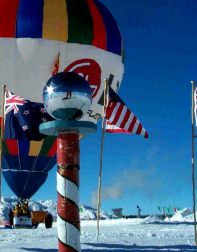|
Curtis Lieber's Wild South Pole Adventure Continued.
The sun is shinning bright, the wind is calm, and it is about -20 degrees
Fahrenheit. The Pilots of the Hot Air Balloon see this as the opportunity
for flying over the pole. We all focus on the balloon preparation as Alfonso
Gonzalez, Ivan Trifonov, and Faust Romeral man this first balloon flight
over the South Pole. The balloon flies majestically over the horizon and
with the snow buggy chasing after it. We become worried as we see no sight
of the buggies return for over four hours, only to find that it broke another
gear box retrieving the balloon.
Tents are pitched beside the commemorative South Pole and the group
sleep for several hours. We are awakened early in the morning by Jerry
Marty of the National Science Foundation, who invites us for a tour of
Amundson-Scott Base. This is truly the privilege I have waited a lifetime
for. Shortly afterward, we have a Russian Orthodox Mass at the Commemorative
South Pole.
We have been at the South Pole for 25 hours. We now must go! That certainly
is a horrifying feeling to see a warm safe American Base fade over the
horizon. We have received radio communications while at the American Base
that Ernst Zinnhobler developed, severe kidney stones and urinary blockage
and over the past three days organized a daring rescue landing at the Middle
camp and evacuated himself and three others.
Now we are racing against time to reach the middle camp. The weather
finally drops the bottom out and we are in the middle of a heavy white
out and wind storm, fortunately it is blowing us northward in the direction
we wish to go. We arrive at the middle camp on January 10 at 8 pm Chile
Time. Everyone at middle camp looks worn and weary. Breaking camp takes
several hours since it has been here for over a week now. We are on our
way by 7:30 am January 11th. The weather is overcast and gray with winds
of 15 mph and blowing snow. It is -40 F with the wind chill.
We drive for over 16 hours when finally the expedition stops and the
drivers simply slump over the wheels and sleep for two hours. Then we go
on for several more hours, of course with our customary mechanical breakdowns
along the way. It's obvious that the order has been given for us to drive
straight on until we reach Patriot Hills. At 72 miles out the Ellesmere
Mountain Chain becomes visible and we begin to pick up speed as our moral
also improves. We stop once more to boil water and cook instant mashed
potatoes and sausage, as the drivers sleep for about two hours.
In the distance off to the west, there is a windstorm heading straight
for us. But we go on and soon we out run it as we round the eastern end
of the Ellesmere Mountain Chain and head straight on to the Patriot Hills
Base Camp. We arrive at the camp on January 12, to the main group that
cheer our return and success at reaching the South Pole.

Now we must wait strategically for an 8 hour
window where the huge Iylushin-76 can fly over Drake Passage from South
America and land here on the blue ice runway, load the expedition and take
off before any bad weather. The jet plane would have to return to South
America if fog or a white out prevented clear visibility of the entire
runway. Likewise the plane would be stranded on the icy runway if fog settled
in before it could take off, because there is no way to fly out of this
mountainous location blindly. It will be 5 days before this opportunity
presents itself.
Until then we explore the nearby wreckage of the DC-6 Norman Vaughn
Expedition Airplane. This plane is six miles from Patriot Hills and crashed
while attempting to land here in 1994. The fuselage of the airplane has
been covered by years of snow and wind but the tail section still marks
the site. Inside the plane, there is an eerie spirit because everything
remains as it was then. Cages for the sled dogs are unopened, and all are
frozen in time.
Joining our camp is a NASA Research Expedition
returning back with us on the Iylushin-76 for South America. They have
successfully found thirteen Meteorites on Antarctica and many have tiny
microbes present. Jim Lovell, astronaut of Apollo 13, suggests that the
meteorites entered the earth's atmosphere with these microbes riding piggyback.
Since there is no bacterial life on the surface of Antarctica, these microbes
had to come from life elsewhere in our galaxy.
The Patriot Hills Camp is enthusiastically
broken down after news that the Iylushin-76 has left South America. The
landing of this huge plane is awesome. We leave Antarctica January 17,
but it remains unchanged as it has for millions of years. It boggles the
mind to think that this huge continent has been lost in time and forgotten
by civilization. Righteously so, that this is the origin of a major part
of our global weather. I am glad that man is unable to make a lasting affect
on this seventh continent of the earth. But for me, I have come to find
myself and see what I was made of, and I have survived!
The End
Copyright by Curtis Lieber Click on the Picture for a Close-up. |
